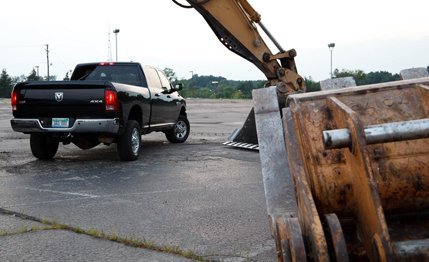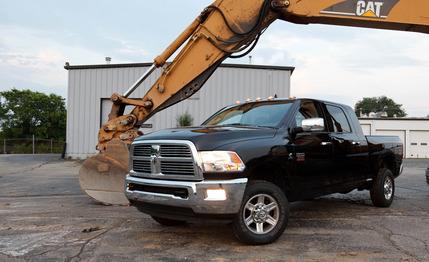
 Long-Term Road Test Wrap-Up
Long-Term Road Test Wrap-Up
Departure Date: August 2011
Current Mileage: 40,848 miles
Months in Fleet: 16 months
Average Fuel Economy: 14 mpg
Average Range: 476 miles
Service: $1198
Normal Wear: $0
Repair: $0


Pickup sales are a popular indicator of housing-market health, but the inhabitants of the house that Walter P. Chrysler built were worrying about other measures of fiscal fitness at the time this heavy-duty Ram was introduced. Between the truck’s first public appearance at the February 2009 Chicago auto show and its launch nine months later, Chrysler filed for and emerged from bankruptcy. During that same time, new housing construction hit its low inflection point.
Fortunately, things are improving: Post-bankruptcy Chrysler is now controlled by Fiat and has rehabbed most of its ailing lineup, and truck sales are rising as the housing market slowly rebounds. Our long-term Ram was a witness to the latter in more ways than one: While the truck was under our care, eight staffers used the heavy-duty hauler to move to a new dwelling, with another handful assisting friends with relocation. We should have stocked the truck’s center console with U.S. Postal Service change-of-address packets.
Quieting the Skeptics with Volume
Before its arrival, some among us wondered whether such a behemoth would be too much vehicle for our needs, especially after having finished a successful 40,000-mile stint in a small-by-comparison 2009 Dodge Ram 1500.Turns out they needn’t have worried: What we ended up with was—to quote ourselves—“one of the baddest-ass off-road executive limos” we’d yet encountered. The spec- and options-sheet highlights: 2010 Ram 2500 Mega Cab, electronic parttime four-wheel drive, the then-top-spec Laramie trim (since eclipsed by the Laramie Longhorn), a Cummins diesel inline-six hooked to a six-speed automatic, monochromatic black paint outside, black leather inside. A full rundown can be found in the truck’s long-term introduction story, but suffice it to say that the thing was loaded. Stocked with nearly every available option, the final bill came to $54,650, or the price of a foreclosed home in a nice neighborhood.
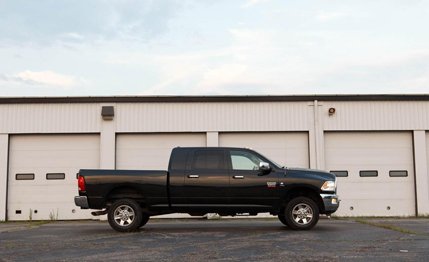

Moving On Up
The truck we chose made a priority of interior space over bed length, as the extra-huge Mega Cab forces a reduction in box size from eight feet to six feet four inches. The rear legroom was coveted, both for people and as a weatherproof and lockable pseudo-trunk in which to store valuables like engine blocks and beer kegs. With the seats folded, the rear compartment was able to house SUV quantities of detritus, as long as items fit through the rear doors. In addition to the aforementioned, whole living-room sets and about half a car’s worth of sheetmetal were transported indoors.
Still, although the interior load floor was nice and flat, some complained that it was too high off the ground, since the Mega Cab’s seats fold forward onto the cabin floor. (In contrast, the seat bottoms in Club Cab Rams flip up to the bulkhead onto which they’re mounted.) The bed’s load height came under similar fire for its loftiness.
“The interior décor represents a nice middle ground between the too-subtle GM HD twins and the overwrought Ford Super Duty,” noted one logbook entry. The cabin’s finish work wasn’t uniformly perfect, though, with some pieces not quite lining up with others, including some speaker grilles and dash panels. The dealer fixed a vibrating center-console lid when we got tired of leaning on it or silencing it with folded-paper shims.
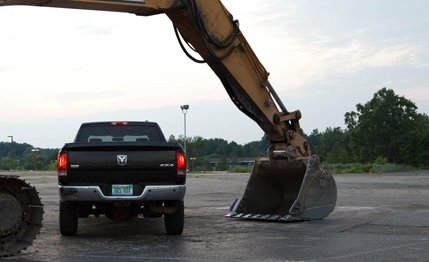

The Laramie’s seat coolers (included with our optional bucket seats) turned out to be a safety feature for at least one driver who “found out you can actually make yourself so uncomfortably cold that it is impossible to nod off while driving. I’m joking. A little.” We generally liked the nav system, which exhibited none of the freezing or hiccups of a similar unit in our long-term half-ton Ram. The navigation still managed to frustrate, however; during one run to the Windy City, the system was seemingly confused by a live stream of info on construction and traffic, Chicagoland’s two main ingredients. “It told me to exit the highway in post-Apocalyptic Indiana and couldn’t decide on a route without recalculating again and again,” wrote the driver. And some found it hard to hit the touchscreen’s virtual buttons—the screen controls radio tuning, and most other functions—while the truck was bounding along without simply stabbing and praying they hit the right one.
Torque, Traction, Towing
The carry-over Cummins diesel six-cylinder suited our needs, providing 350 hp and 650 lb-ft of torque to the rear wheels most of the time or to all four with the turn of a knob. To keep pace with its Ford and GM competitors, Ram introduced a high-output version of the engine with 800 lb-ft of torque for 2011.
We easily made do without the extra grunt, and our towing aficionados—largely our resident race-car owners—hogged the Ram on most summer weekends. They praised the engine-exhaust brake’s cooperation with the transmission’s tow/haul mode, which provided aggressive downshifts. The truck’s cruise control kept pace even when towing on hills, and we observed no tendency to wander on freeway hauls. The integrated brake controller had its fans, and the brake pedal’s initial softness avoided lurching stops with heavy loads, although it required more pressure later to come to a complete halt. (The pedal’s long travel and slop did make for some anxious stops when the truck was unburdened, however.) “An excellent tow rig,” noted technical editor Michael Austin, “but for the price it had better be.” Stability control was only notable by its absence on the spec sheet, not because we missed it; it is now standard for all 2012 HD Rams, however, and this change brings the Ram in line with the rest of the full-size-truck market. Our truck’s only traction aid was its extra-cost limited-slip rear differential.
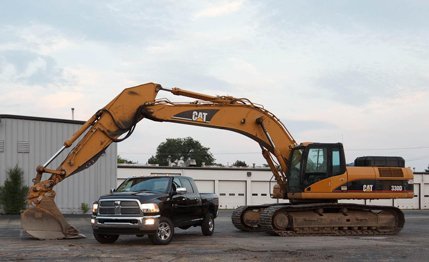

Although its suspension was quite stiff, the Ram’s long, 160.0-inch wheelbase delivered a smoother-than-expected ride while towing or unladen, with only heavily pocked pavement sending big judders through the cabin. This is the longest truck Ram offers, but the black monster was (relatively) easy to maneuver, even taking into account its rather massive turning circle. Slow but accurate steering helped in this regard—and in delivering the straight-line stability we mentioned earlier—as twitchiness isn’t something you want in the helm of something this large. The truck’s acceleration remained consistent over the test, with 8.4- and 8.5-second 0-to-60-mph times being recorded in initial and final testing, respectively.
The big diesel did match our previous 1500 in one surprising way: fuel economy. Burning diesel rather than the smaller truck’s gas, the much heavier 2500 (7260 pounds versus 5680) averaged the same 14 mpg. We saw as high as 17 mpg in highway driving with nothing hooked to the back and between 12 and 15 with a trailer. We averaged 476 miles between fill-ups and saw a high of 516. When we did need to stop, the nav setup’s listing of service stations with diesel fuel proved handy.
Lots of Oil, Let There Be Light
Service costs were about on par with those of the previous long-term Ram. The difference was accounted for by the quantity of oil the diesel requires: 12 quarts. Each of seven oil changes, performed at the onboard computer’s request, ran about $110. Otherwise, this Ram got by with simple maintenance: two fuel filters, two air filters, and several tire rotations and inspections. Between mileage-interval-based services and oil changes (some of which, thankfully, overlapped), the Ram went in 11 times for regular maintenance. Two unscheduled service appointments were required—the first to replace a key-fob transmitter gone haywire and the second to replace an O2 sensor—both of which were covered under warranty. While the truck was in for another service, the dealer replaced the power-steering-reservoir cap as a result of a recall; the power-steering pump provides the pressure for brake boost, and the cap might vent improperly and cause a slow return of the brake pedal. The truck’s original tires lasted the duration of the test, and for once, we didn’t break anything.
We did make an improvement to the truck, one we wish we’d thought of earlier in its stay. Like those of our 1500, this Ram’s headlights demonstrated inadequate illumination abilities. We solved the problem with a set of Sylvania SilverStar Ultra bulbs for the high- and low-beams (about $100 for all four) and recommend the modest investment to anyone buying a new Ram.
Was it too much truck for day-to-day driving? Opinions were mixed, although the Ram had full support as an occasional-use vehicle. A smaller truck or even one with fewer amenities would accomplish most tasks, as would a rental, but for someone with frequent needs, a loaded 2500 like ours has its place in the market. Technical editor K.C. Colwell may have put it best: “I’m not sure why anyone this side of a cattle rancher would buy a truck like this—but God bless ’Murika.” What’s the market like for ranches these days, anyway?
